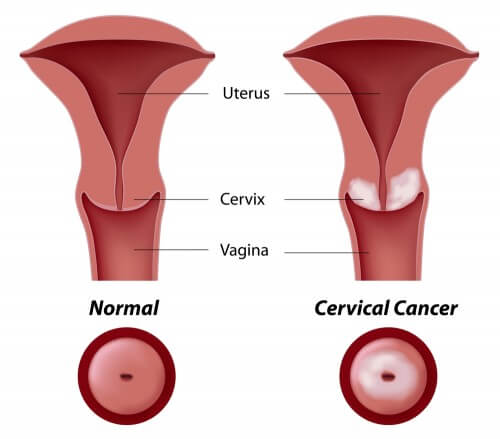Imagine what would happen if the vaccine was given to everyone? say experts from the US Centers for Disease Control

The Ministry of Health may cause an unnecessary increase in the incidence of cervical cancer, if it responds to the demand of gynecologists and doctors specializing in autoimmune diseases who demanded to stop the mass vaccination operation Because of girls who allegedly had side effects. Among other things, it is claimed, the vaccine may be associated with various symptoms, starting with local symptoms at the injection site, such as pain and redness, through general symptoms such as headaches, nausea and dizziness, fainting, vein thrombosis, and widespread pain in the limbs. It is also claimed that its use may cause various neurological symptoms.
However, in front of all these phenomena, which the experts disagree about, stands a very serious phenomenon of the disease itself - death at a young age. A study by the US Centers for Disease Control (CDC) Published about a month ago Determined that the rate of infection with the human papillomavirus (NPV) among women aged 14-59 decreased in the years after the start of vaccination (2007-2010) compared to the last period before vaccination (2003-2006). In June 2006, the CDC recommended that girls be vaccinated, and the vaccination campaign began in early 2007. The data was collected as part of a study conducted by the National Health and Nutrition Examination Survey (NHANES) - an ongoing study conducted by the CDC and includes a questionnaire in parents' homes that includes physical examinations, Demographic data and sexual history. Self-sampling of the cervix was obtained from all participants who reported receiving the vaccine. The researchers tested the prevalence of 37 types of HPV and divided the subjects into six groups between the ages of 14 and 59.
Among the group of sexually active girls aged 14-19, the frequency of each of the types of viruses, and in particular those against which the vaccine works in the most effective way, was lower after the period in which vaccines were given compared to the period before it. According to the researchers, the effectiveness of the vaccine reached 82%. The researchers came to the conclusion that after the recommendation to give vaccines, the number of infections with viruses against which the vaccine works decreased by 56% among girls aged 14-19, although the rate of vaccination is still low, one could only speculate what would have happened if the rate of vaccination had approached 100%.
The two components of the vaccine, Gardasil and Cervarix, are supposed to provide protection against infection with certain strains of the virus, which are associated with the development of cancer. They are approved for use in girls and women (Gradesil is also approved for use in boys) and are given in many countries around the world.
Penn State University dedicated this week the corner "The Medical Minute" to the topic:
"The human papillomavirus, or HPV, is the most common sexually transmitted disease today. HPV is the main cause of cervical cancer but may also cause other types of cancer in women and even in men. The virus may affect the genitals, mouth and other areas, but there are those who carry the virus and don't know it.
However, HPV can be prevented by vaccination. In this week's (September 4, 2013) edition of Penn State University's Health Project, Dr. Rollin Ornstein talks about the importance of getting vaccinated against HPV, especially at an early age.
"It is very important to get vaccinated before starting sexual activity," says Orenstein. "In addition, the immune system of children aged 9,10,11 will provide a better response to the vaccine, so it is important to get vaccinated early."
The HPV vaccine involves a series of three injections within six months, with all injections essential to provide the best protection. According to the Center for Disease Control and Prevention, the HPV vaccine is recommended for girls and boys aged 11-12, but older adults can also enjoy the benefits of the vaccine.
- To the page dealing with HPV on the website of the Center for Disease Control and Prevention
- For a detailed information page about HPV on the Penn State University website
- For information on the Penn State University website
- The 2008 Nobel Prize in Medicine for discovering the link between the papilloma virus and cervical cancer

3 תגובות
Max
You didn't understand Uri's claim. He said that monitoring at-risk conditions (pre-cancerous risk) makes girls who are at risk more careful. Girls who are not at risk do not belong in the story. The effect of surveillance alone for risk situations on cancer reduction is well known for breast cancer (surveillance for suspicious lumps) and for colon cancer (surveillance for abnormal polyps).
Uri, I have one problem with your claim.
The percentage of sexually active girls under the age of 18 has increased in the last decade.
What has decreased is the rate of unwanted pregnancies at these ages.
the difference?
Easier access to contraceptives, and of course, education about correct sex.
As was said before:
Abstinence is not a cure for anything.
Regarding the percentage of cancer patients, it decreased significantly also because the extensive publicity increased the awareness among those young women and their parents, of the details of the disease, its dangers and especially its causes. It makes sense that this caused some of them to avoid or reduce sexual relations, and some of them used appropriate protective measures and more. Perhaps the direct effect of the vaccine is much smaller than published.